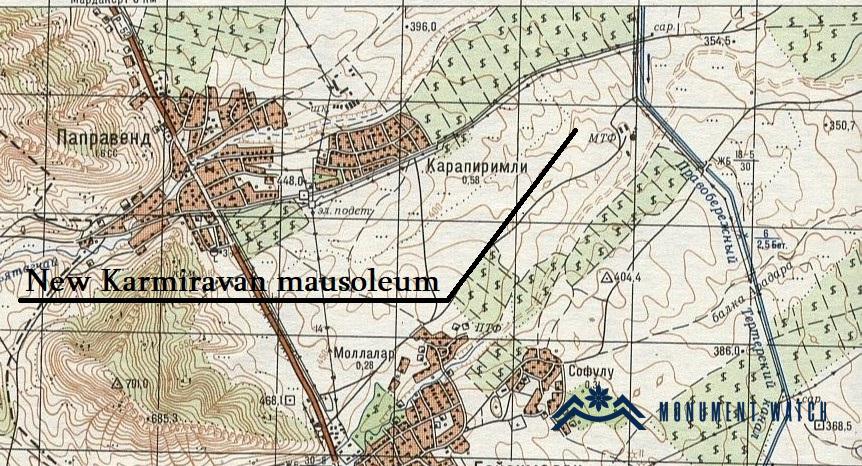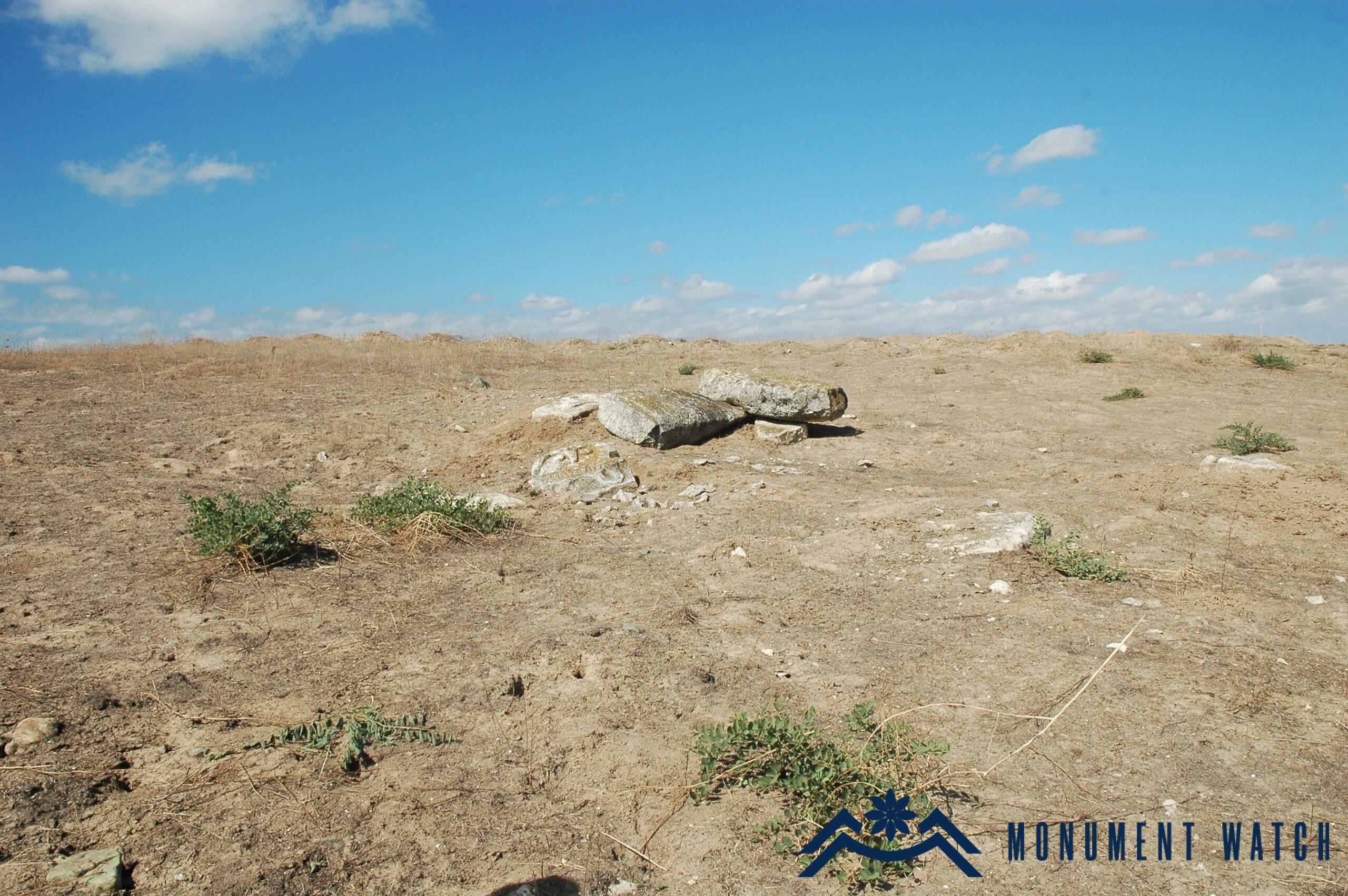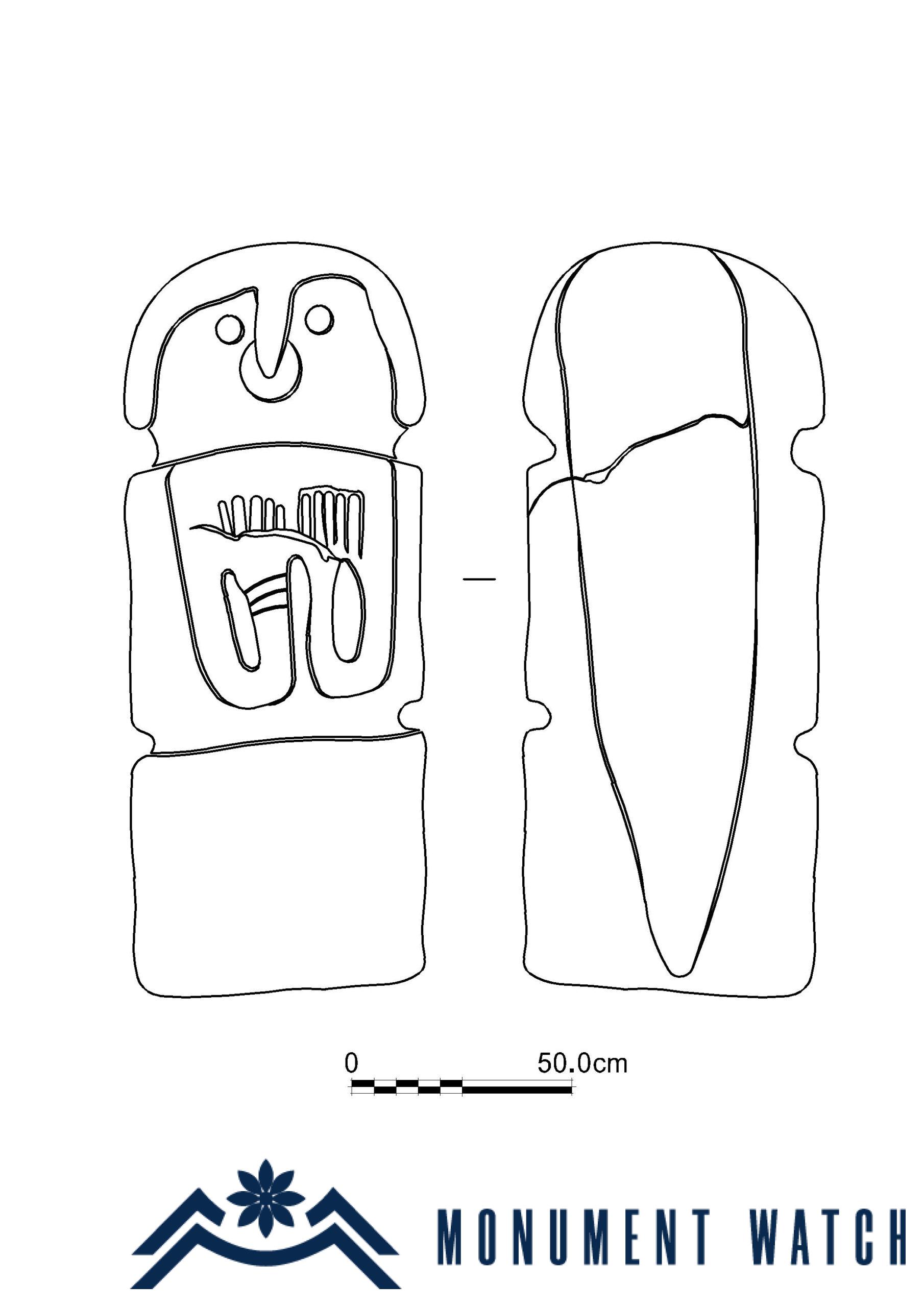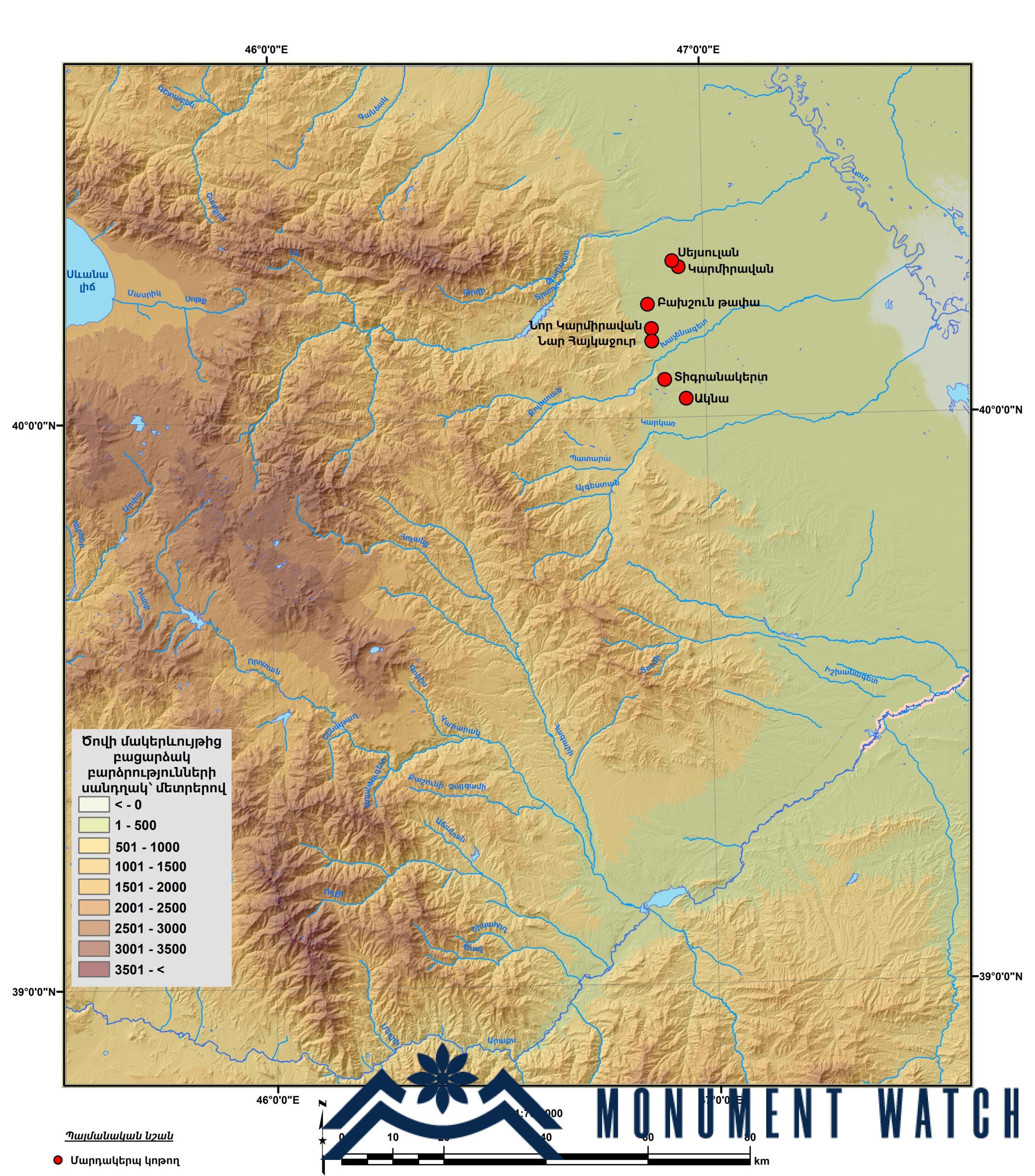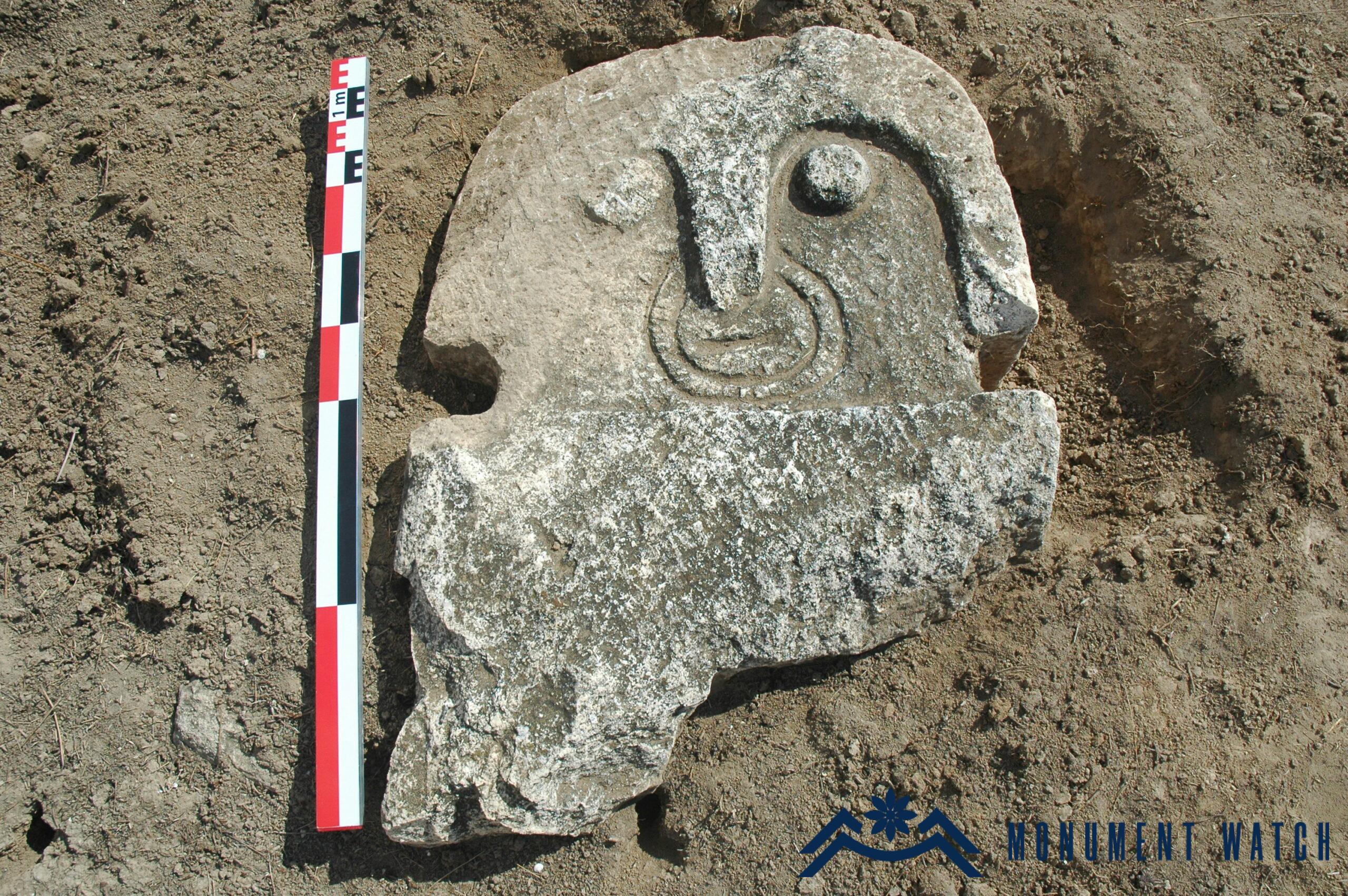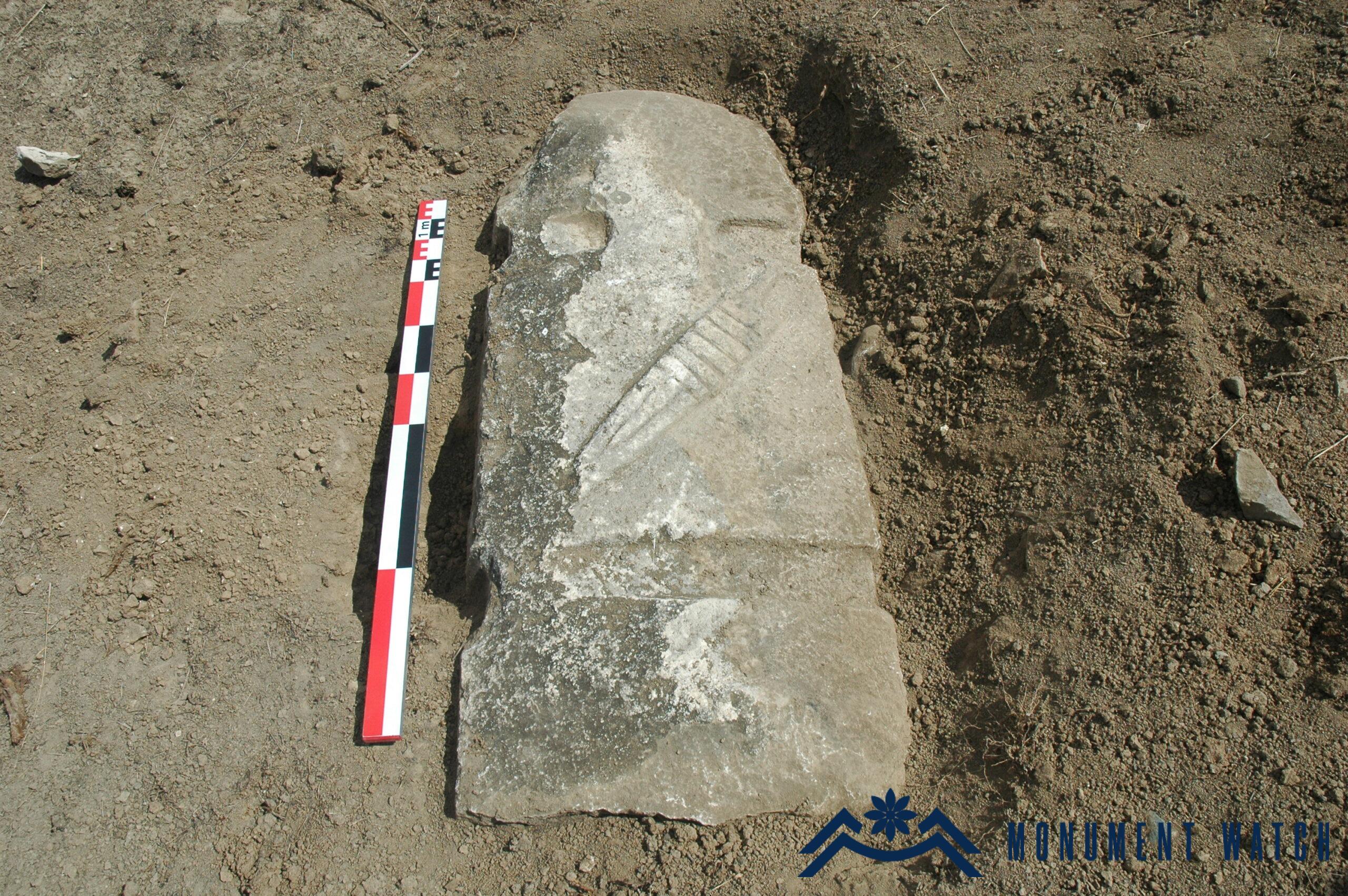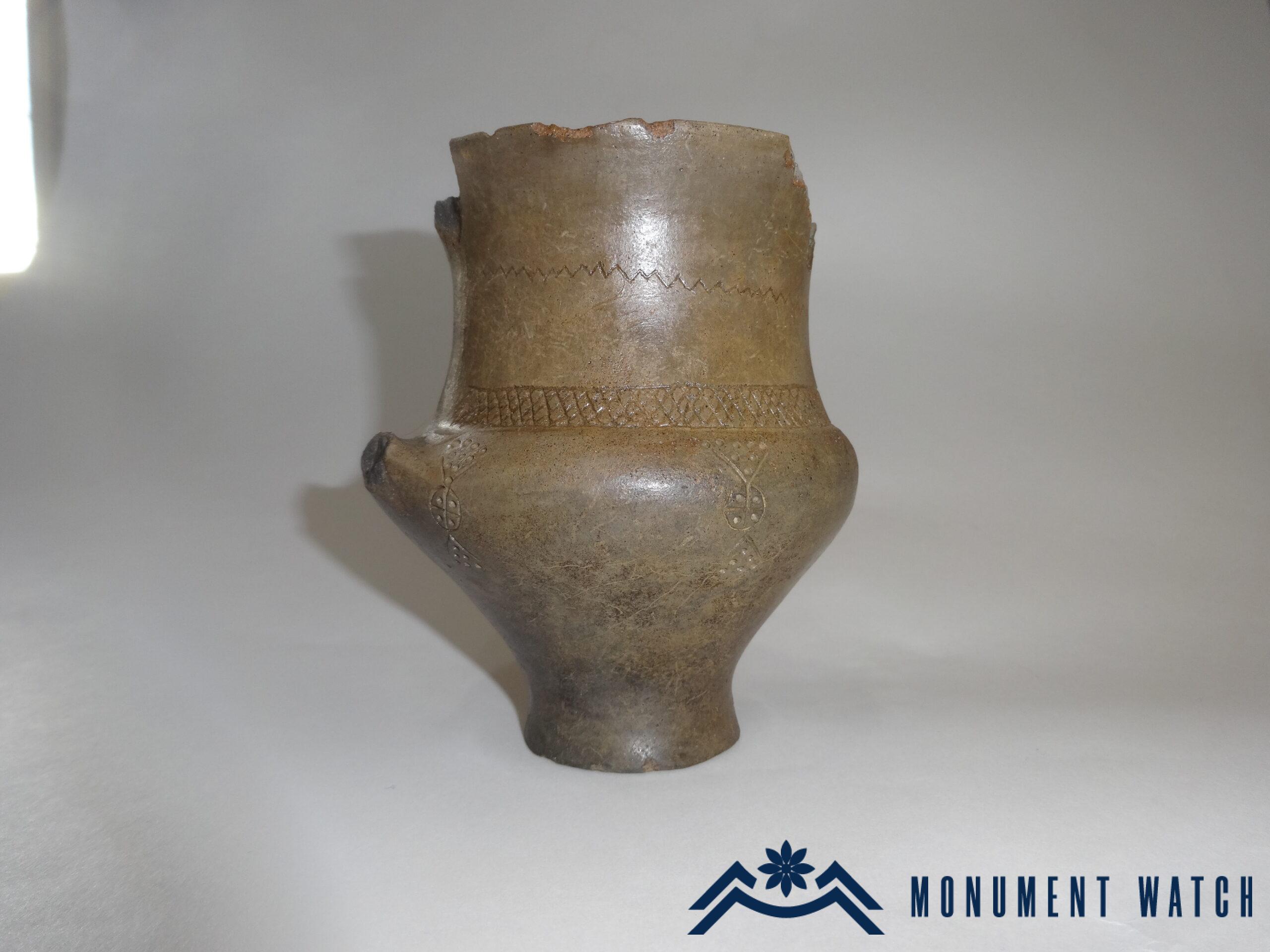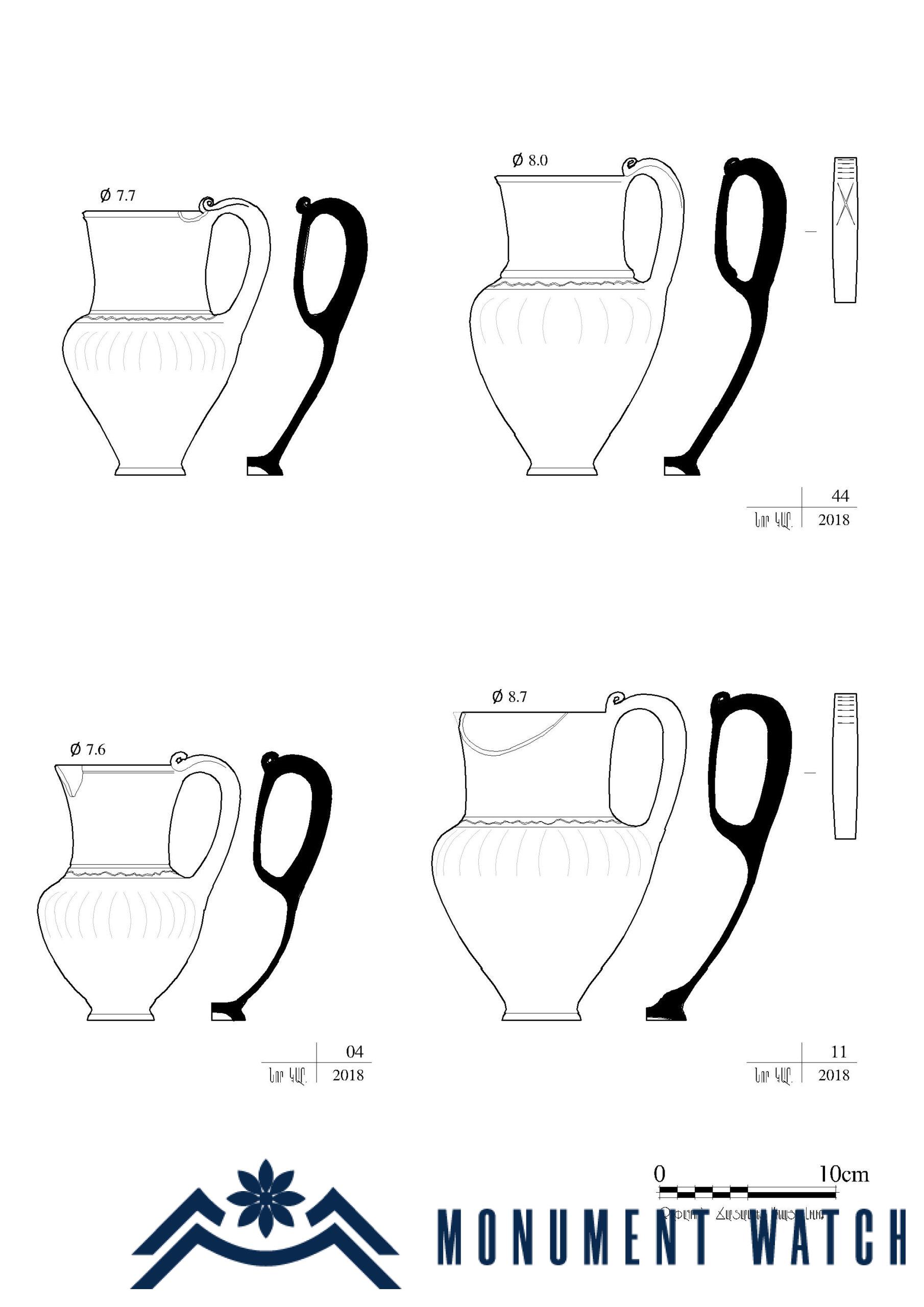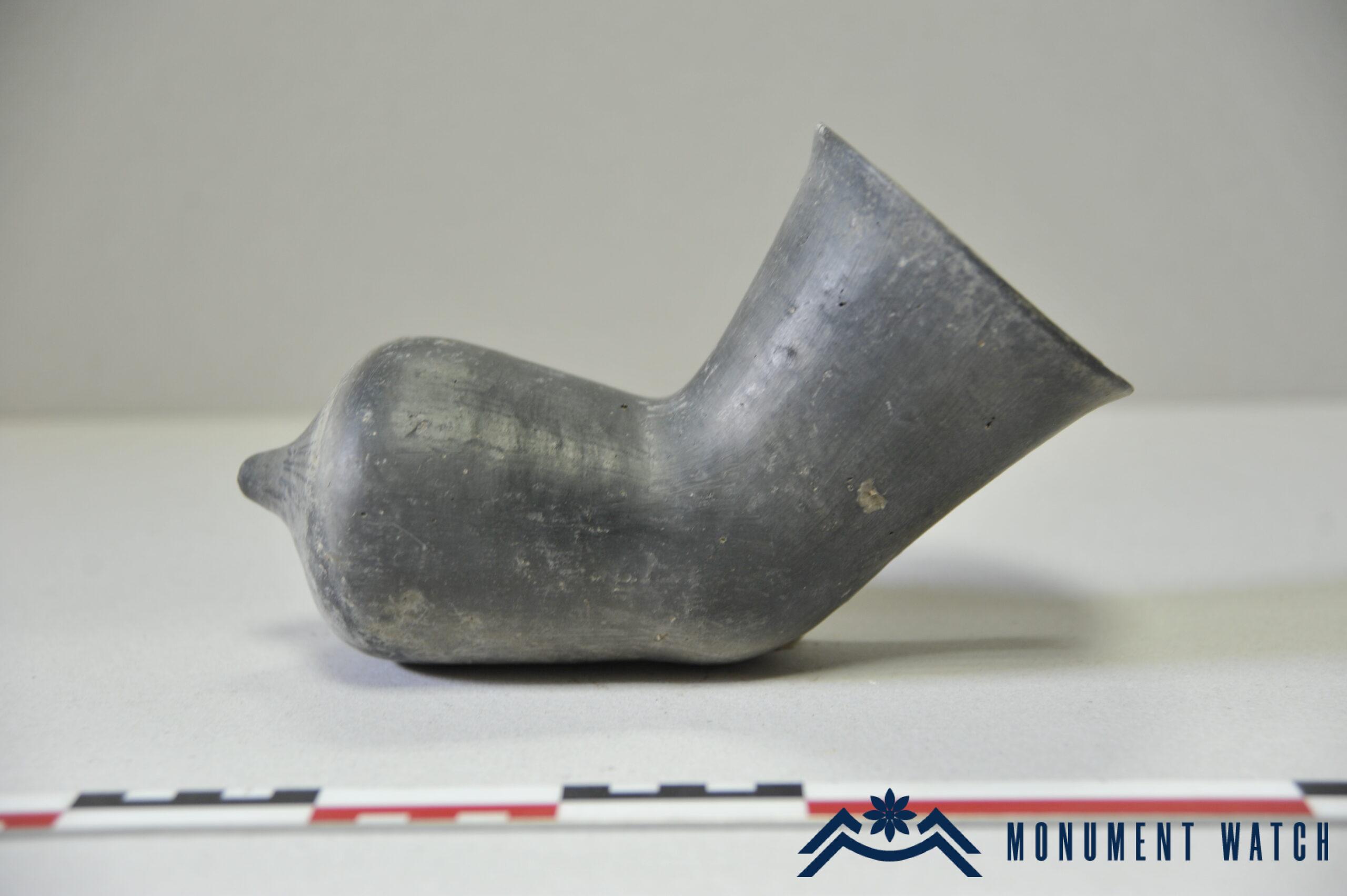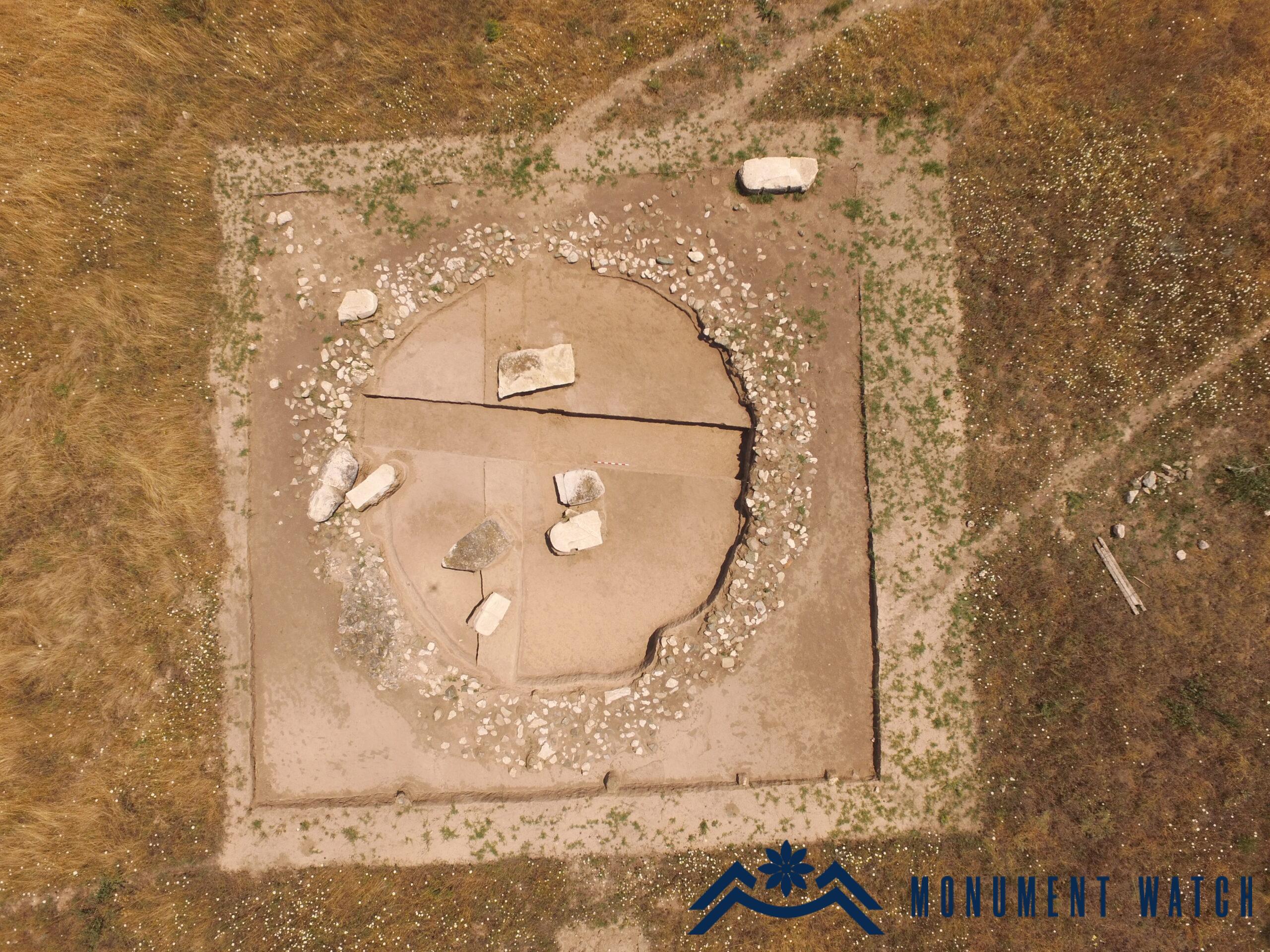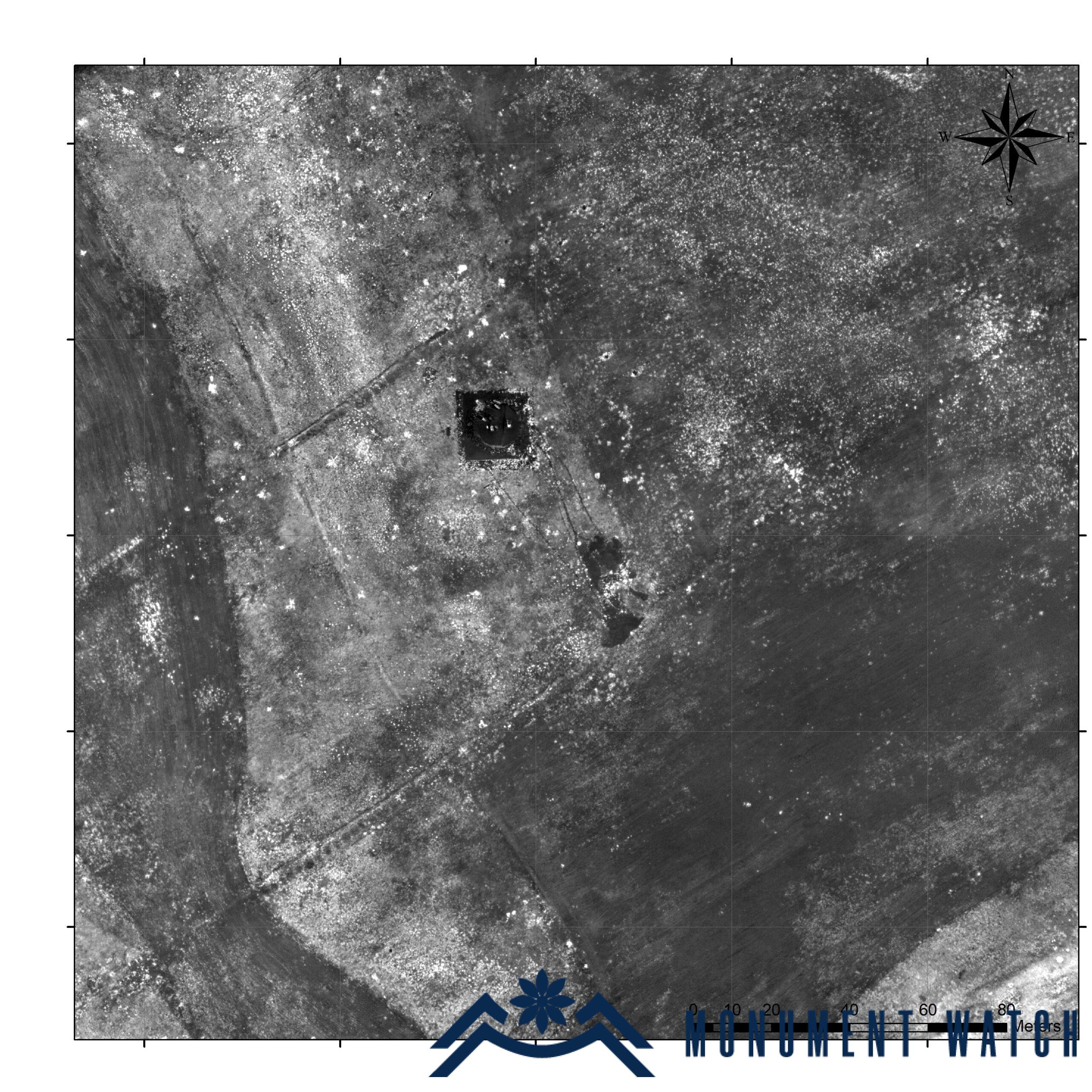The archaeological survey of the Nor Karmiravan mausoleum
The discovery of stelae
In 2016, a resident accidentally discovered about a dozen anthropomorphic stelae and some fragments in the village of Nor Karmiravan, located in the Martakert region. The concentration of these stelae in one area, along with specific features of the surrounding landscape (Fig. 1), suggested that the stelae were likely still in their original locations. To verify this hypothesis, excavation work was planned following an initial exploration of the site. These excavations were to be carried out both around the stelae and in the vicinity of a nearby dug canal.
The main goals of the excavations were:
- To study the stelae of Nor Karmiravan and clarify their archaeological context through excavations.
- To determine whether the stelae found in Nor Karmiravan are in situ or have been relocated.
- Answering these questions led to further inquiries about when and for what purpose the anthropomorphic stelae of Artsakh were erected.
Currently, the village of Nor Karmiravan is occupied by Azerbaijan.
The stelae in question are flat, oblong slabs rendered anthropomorphic through their dimensions and sculptural processing. Two carved horizontal grooves divide the slabs into three parts, representing the head, torso, and lower part (Fig. 2). These stelae are found throughout the longitudinal area of Artsakh, where the highlands and the steppe merge, covering approximately 30-40 km (Fig. 3). They are particularly concentrated in the northeastern regions of the Republic of Artsakh (Nagorno-Karabakh), around Martakert, Tigranakert, and the nearby Gyavurkala settlement (Yeranyan 2021, 248-254). During the Soviet era, several of these stelae were relocated to the Artsakh State Museum and the courtyard of the Martakert Historical and Geological Museum, though some remain in the open field.
The archaeological environment of the New Karmiravan mausoleum
A majority of the approximately dozen anthropomorphic mounds verified in Nor Karmiravan were gathered in one location (Fig. 4). Additionally, two stelae were uncovered 100–150 meters northeast of this main site (Fig. 5), two others were found in the yard of an abandoned house in the village, a third was unearthed during engineering work, and a few fragments were scattered around the area.
No prior discovery of any of the more than two dozen stelae in Artsakh had shown such a concentration in one location. Consequently, it appears likely that these stelae are in their original positions due to the clustering of the mounds and certain geographical features.
Excavations
From 2016 to 2018, excavations were conducted at two main sites:
- The primary location where the stelae were mainly accumulated.
- Approximately 200 meters northwest of this site, near a canal constructed in the second half of the 2000s.
Excavation of the Canal Site
In the first year, excavations were conducted simultaneously at two sites. During the exploration work near the stelae, a single-handled small pitcher was found at the bottom of the canal (Fig. 6). It was broken from the bulging body upwards, including the rim. Excavations revealed an underground burial at a depth of 1.1 meters. The anthropological material included a skull and various skeletal fragments. Additionally, 18 vessels and beads made of faience, cornelian, and bronze were discovered. The archaeological material was incomplete, and the integrity of the skeleton was compromised. Some bones were found under the skull, while others were scattered around the vessels. The skeleton's position was likely disturbed during the construction of the canal.
The discovered materials, including those with a black sheen torso, are typical of artifacts found in Artsakh and other stelae in the region. Some of these artifacts can be dated to the 9th-8th centuries BC, while others date back to the 7th-6th centuries BC. It should be noted that although excavations confirmed only one burial, previous archaeological expeditions in Artsakh, during the construction of the canal, also accidentally uncovered shell vessels in other areas (Petrosyan et al. 2008, 187-200).
The excavations of Mausoleum
The next primary excavation site was the area surrounding the accumulation of stelae. Excavations here confirmed the presence of an 11-meter diameter cromlech structure with a circular plan. Upon removing a layer of soil approximately 50-70 cm deep, it was discovered that the burial pit was situated nearly at the center of the cromlech. The underground burial chamber had a rectangular shape, with a deviation of 30 degrees east-west. It measured 6.4 meters in length and 1.6 meters in width. The burial chamber exhibited a gradual slope along its longitudinal axis, consistent with its orientation (Fig. 7).
In the northeastern part of the burial chambers, the excavation revealed a fragmented skull of the deceased at a depth of 70 cm. The entire layer contained bones from various animals, with the bottom 30 cm layer filled with seashells. Additionally, a horse burial was uncovered in the western part of burial chambers, accompanied by parts of a horse bridle and horse decorations.
Similar burial structures are not uncommon in this region. Underground kurgans with single burials are also characteristic of the Ivanyan (Khojalu) burial ground, forming a distinct group (Kushnareva 1970, 110). The construction of such mausoleums suggests the concerted effort of society. Therefore, the presence of single burials may be explained by the strong social stratification and the heightened importance of individuals within this society, such as leaders, warriors, priests, and other esteemed figures.
The burial artifacts found in the Nor Karmiravan mausoleum can be categorized into beads, weapons, horse bridle and grooming parts, and shells. Notably, the largest group consists of pottery, which is further divided into several types.
The pottery materials were mostly complete, with a total of 41 vessels discovered (Yeranyan, Zarikyan, Simonyan 2023, 275-278). These vessels exhibit a variety of forms, but all belong to nearly the same period. The pottery can be classified into the following types: single-handled and double-handled amphoras, single-handled small pitchers, crocks, rhythons, churns, little bowls, and jars (Figs. 8-10).
In addition to the listed artifacts, various parts of the burial chamber, including the area under the skull of the deceased, contained fragments of a broken vessel. Some researchers suggest that breaking objects and burying them in a mausoleum signifies subjecting them to a ritual death, which is believed to be connected to ideas of the deceased's rebirth (Tumanyan 2010, 154-155).
The metal artifacts found in the mausoleum are relatively scarce. It comprises bronze pendants, bronze Scythian-type arrowheads, several bronze beads, and a fragment of an iron bridle.
The discovered arrowheads are typical of the "Scythian type" found in the South Caucasus, dating from the 8th century BC onwards.
Among the materials accompanying the horse's burial, several parts of a bone bridle were also found in the mausoleum, which has a horse's head in the upper part of the end, a horse's hoof-shaped ends in the lower part, and three cored holes in the middle part. Similar sculptures are widespread in the stelae of the Black Sea regions and Eastern Europe and date back to 1000 BC. 7-6th century and are associated with Scythian animal-style sculptures (Kantorović 2016, 101-108).
A pear-shaped mace made of granite with a cored hole was found on the floor of the mausoleum. The latter was most likely made from earlier iron prototypes and is found in stelae dating back to the 15th-13th centuries BC (Piller 2013, 309).
A similar stone pear-shaped mace was discovered in the Middle Bronze Age layer of Old Shirakavan. Bronze examples have also been unearthed in Lchashen, Gavar, and Artik, dating back to the 14th-8th centuries BC. This illustrates the enduring use of such weapons (Torosyan, Khnkikyan, Petrosyan 2002, 17, 43).
Of particular interest is the wealth of beads made from faience, carnelian, and bone found in the eastern corner of the mausoleum. The collection of nearly 5,000 beads in various colors likely adorned cloth used in burial rituals.
Additionally, the mausoleum contained over 300 snail shells, covering the entire floor. Various objects, including stones placed for purification and protective charms, were part of each burial ritual (Tumanyan 2010, 147). The practice of covering the mausoleum floor with shells likely held ritual significance, associated with beliefs in purifying the space.
The study of paleontological materials
The paleontological materials recovered from the excavations at Nor Karmiravan were studied by P.H.D. N. Zarikyan.
The animal species identified were predominantly domesticated: 6 small cattle (sheep/goat) Ovis aries/Capra hircus, 2 cows Bos taurus, and 4 horses Equus caballus. Additionally, remains from wild animals included 1 European roe deer Capreolus, 1 feline from the family Felidae, and 1 wild bull Bos primigenius (Hillson 2009; Prehn et al. 2018).
The study of anthropological materials
The anthropological material obtained from the excavations of Nor Karmiravan was studied by anthropologist H. Simonyan.
Among the anthropological findings, a fragmented and incomplete skull was identified. The missing parts include sections of the temporal bones, bones of the frontal skeleton on both sides, the left wing of the lower jaw, and part of the body. The skeleton is almost complete, although the long bones are fragmented post-mortem. The individual's age at the time of death was determined to be between 30 and 40 years old. Based on the analyses, the skeleton belongs to a male.
A History of Anthropomorphic Stone Stelae
As previously mentioned, none of the approximately three dozen anthropomorphic stone stelae known in the steppes of Artsakh had been authenticated in their original locations. Thanks to various excavations and research efforts, we managed to establish only the lower limit of the date of these stelae (Yeranyan 2021, 250-251).
However, an iconographic comparison with other similar stelae in the region allowed us to date the anthropomorphic stelae of Artsakh to the beginning of the 1st millennium BC, specifically the 8th-6th centuries BC. This hypothesis required further confirmation or refutation. Therefore, the discovery and excavation of the stelae in situ provided crucial insights into this important question.
An important argument for dating the mausoleum was the archaeological material found within it. Without detailing the entire variety of artifacts, it is noteworthy that the discovered items have parallels in the stelae of Armenia, Transcaucasia, and Iran.
The majority of the materials correspond to the pottery typical of the period of widespread iron use in the South Caucasus. The discovered items date back to the 8th-7th and 7th-6th centuries BC, with some pieces showing similarities to earlier examples from the region.
Laboratory C-14 analysis of the anthropological sample from the tomb indicates a date of 2486±30 BP (late 6th - early 5th century BC). This dating supports the conclusion that the Nor Karmiravan tomb, along with the associated stelae, can be dated to approximately the 8th-6th centuries BC.
The function of anthropomorphic stelae
The excavations of the Nor Karmiravan mausoleum and the broader research around the tombstones provide valuable insights into the possible connection between the tombstones and the mausoleum, shedding light not only on their dating but also on their function.
Following the establishment of their dates, the question of the function remains critical. The excavations have helped clarify this aspect to a significant extent.
Despite the stelae being found in a lying position and potentially having shifted over time—especially considering the landscape alterations due to the installation of irrigation pipes during the Soviet era—they were discovered within the tomb cromlech. This strongly suggests that the stelae are indeed associated with the mausoleum. While it is challenging at this stage to determine their exact relationship, positioning, and orientation within the tomb (Fig. 11), the findings confirm their connection to this burial site.
In the vicinity of the excavated tomb at Nor Karmiravan, we conducted aerial photography using an infrared filter (operator: A. Mkrtchyan). The images (Fig. 12) revealed, and subsequent exploratory excavations confirmed, the presence of additional mausoleums in the area. This indicates that the site is part of a larger cemetery, where valued burials took place and the discussed anthropomorphic stelae were erected on-site.
Bibliography
- Yeranyan, Zarikyan, Simonyan 2023 - Yeranyan N., Zarikyan N., Simonyan H., Examining the dating and functions of Artsakh anthropomorphic stelae in the light of Nor Karmiravan excavations, Journal of Social Sciences, 3 (669), 271-296.
- Torosyan, Khnkikyan, Petrosyan 2002 - Torosyan R., Khnkikyan O., Petrosyan L., 2002, Old Shirakavan, Yerevan, Science.
- Tumanyan 2010 - Tumanyan G., Tumanyan, Observations on some issues related to the property of Late Bronze Age burials in Armenia, Journal of Historical Studies, 2010, 3, pp. 147-160.
- Petrosyan and others 2008 - Petrosyan H., Khachatryan Zh., Piliposyan A., Hakobyan H., Safaryan V., Kirakosyan L., The first results of the archaeological survey of Tigranakert and its surroundings in Artsakh, Armenian National Museum, 2008, XIV, Yerevan, RA NAS "Science " publishing house, 2008, p. 187-200.
- Hillson 2009 - Hillson, Mammal Bones and Teeth: An Introductory Guide to Methods of Identification (UCL Institute of Archaeology Publications (LCP)), University College London institute of Archaeology, 2009, p. 64.
- Piller 2013 - Piller Ch., The Caucasian connection - Reflections on the transition from the Late Bronze to the Early Iron Age in Northern Iran and its connections to the Southern Caucasus, Schriften deS ZentrumS für Archäologie und KulturgeSchichte deS SchwArZmeerrAumeS, 2013, 22, p. 305-317.
- Prehn, Feneru 2018 - Prehn, N., Feneru, F., & Rochester, J. (n.d.), Beginner’s guide to identifying British mammal bones. London: Natural History Museum, 2018, 54 p.
- Yeranyan 2021 - Yereanyan N., Main Results of the Study of Anthropomorphic Stelae in Artsakh, Archaeology of Armenia in regional context, 2021, Yerevan, p. 248-254.
- Kantorovich 2016 - Kantorovich A., The Image of a Horse in the East European Scythian Animal Style, the Caucasus, and the Steppe at the Turn of the Late Bronze and Early Iron Ages (Proceedings of the International Scientific Conference dedicated to the memory of Maria Nikolaevna Pogrebova, Moscow, April 25–27, 2016), 2016, Moscow, pp. 89–114.
- Kushnareva 1957 - Kushnareva K., Some stelae of the late Bronze Age in Nagorno-Karabakh, Soviet Archaeology, XXVII, 1957, 135-177.
The archaeological survey of the Nor Karmiravan mausoleum
Artsakh
